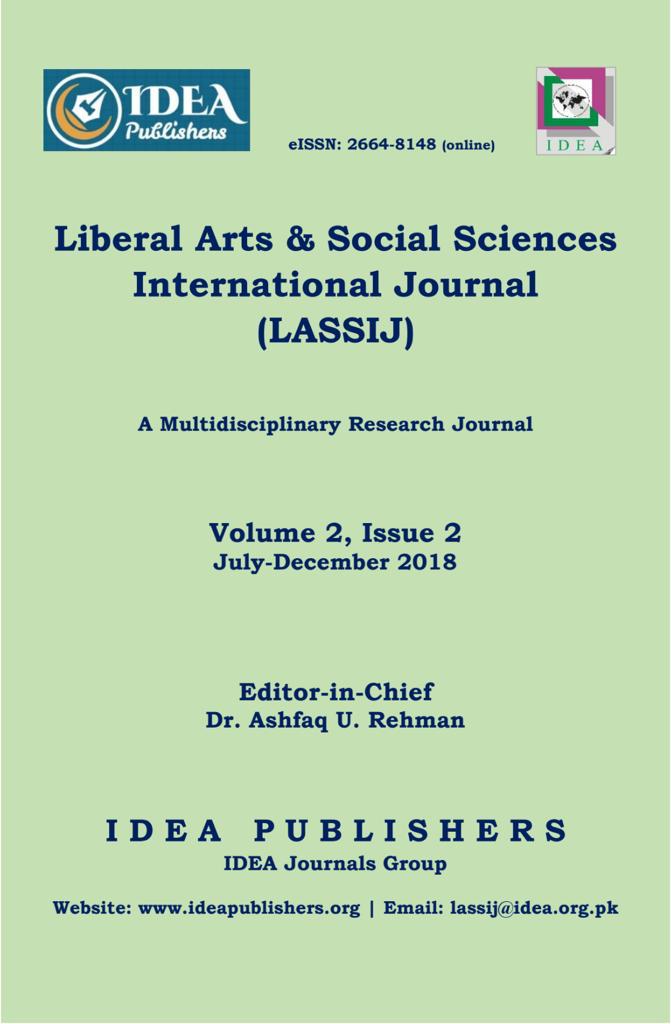Political Reforms and Women Political Participation in the Khyber Pakhtunkhwa, Pakistan
DOI:
https://doi.org/10.47264/idea.lassij/2.2.8Keywords:
Political Activists, Political Awareness, Political Reforms, Election Reforms, Women Empowerment, Women Role in PoliticsAbstract
Women’s political participation strengthens their political as well as over-all empowerment. The discourse of women’s political participation is a matter of concern in the academic circles across the world. This study focuses on the effect of political reforms on women’s political participation in the province of Khyber Pakhtunkhwa (KP), Pakistan. Furthermore, this study focuses on the effect of political reforms on women’s public and civic engagements which further contribute to their political participation. To unearth the mentioned effect, this study uses positivist research paradigm which guides quantitative methods and procedures. A sample of 400 hundred respondents was selected through random sampling technique and data was collected through structured questionnaire. Data for the study is collected from two tehsils of Swabi and Mardan. Liberal feminist theory is used as theoretical framework in this study to examine the question of the effect of political reforms on women’s political participation. Independent sample t-test was employed to analyze the effect of political reforms on women’s political participation. The study finds positive effects of the political reforms on women, like awareness about these reforms and civic engagements. The study recommends that women political participation could be enhanced by improving their level of education.
References
Ali, A. A., & Akhtar, M. J. (2012). Empowerment and political mobilization of women in Pakistan: A descriptive discourse of perspectives. Pakistan Journal of Social Sciences, 32(1), 221-228. https://citeseerx.ist.psu.edu/viewdoc/download?doi=10.1.1.701.226&rep=rep1&type=pdf
Alison, M. (2004). Women as agents of political violence: Gendering security. Security Dialogue, 35(4), 447-463. https://doi.org/10.1177%2F0967010604049522
Aurat Foundation (2012). Legislative quotas for women: A global and South Asian Overview of types and numbers. Retrieved from, Legislative Watch Program for Women Empowerment: https://www.af.org.pk/pub_files/1358744372.pdf
Badshah, L., Rehman, A. U. & Muhammad, N. (2018). Political determinants of voting behaviour in Khyber Pakhtunkhwa. Liberal Arts and Social Sciences International Journal (LASSIJ), 2(1), 1-10. https://doi.org/10.47264/idea.lassij/2.1.1
Bacchi, C. L. (1999). Women, policy, and politics: The construction of policy problems. Sage.
Bano, S. (2009). Women in parliament in Pakistan: Problems and potential solutions. Women Studies Journal, 23(1), 19-35. http://www.wsanz.org.nz/journal/docs/WSJNZ231Bano19-35.pdf
Bari, F. (2005, November 3). Women political participation: Issues and challenges. In United Nations Division for the Advancement of Women Expert Group Meeting: Enhancing Participation of Women in Development through an Enabling Environment for Achieving Gender Equality and the Advancement of Women. Bangkok.
Beauvallet, W. & Michon, S. (2009). General patterns of women's representation in the European Parliament: Did something change after 2004? GSPE Working Paper, presented during fourth Pan-European conference on EU politics on 25/09/2008.
Dawn (2011, January 3). Veteran social worker Tazeen Faridi dead. Retrieved from: https://www.dawn.com/news/595693
Geisler, G. (2000). Parliament is another terrain of struggle: Women, men, and politics in South Africa. The Journal of Modern African Studies, 38(4), 605-630. https://www.jstor.org/stable/161511
Jalalzai, F., & Krook, M. L. (2010). Beyond Hillary and Benazir: Women’s political leadership worldwide. International Political Science Review, 31(1), 5-21. https://doi.org/10.1177%2F0192512109354470
Jafar, A. (2005). Women, Islam, and the state in Pakistan. Gender Issues, 22(1), 35-55. https://link.springer.com/article/10.1007/s12147-005-0009-z
Khan, Z. (2011, November 15). National Assembly passes landmark Women’s Rights Bill. The Express Tribune: https://tribune.com.pk/story/292165/prevention-of-anti-women-practices-bill-unanimously-approved-by-na/
Khan, M. & Ahmad, A. (2016). The protection against harassment of women at the workplace act 2010: A legislative review. LUMS LAW Journal, 3(1), 91-99. https://sahsol.lums.edu.pk/law-journal/protection-against-harassment-women-workplace-act-2010-legislative-review
Keskin-Kozat, B. (1997). Political participation patterns of Turkish women. Middle East Review of International Affairs, 1(4), 1-5. https://ciaotest.cc.columbia.edu/olj/meria/meria198_keskin.html
March, J. G., & Olsen, J. P. (1996). Institutional perspectives on political institutions. Governance, 9(3), 247-264. https://doi.org/10.1111/j.1468-0491.1996.tb00242.x
Naazer, M. A., Mahmood, A., & Ashfaq, S. (2017). Political rights situation during Musharraf Era: 1999-2004. Liberal Arts and Social Sciences International Journal (LASSIJ), 1(1), 20-31. https://doi.org/10.47264/idea.lassij/1.1.3
Norris, P. (2006). The impact of electoral reform on women's representation. Acta Política, 41(2), 197-213. https://link.springer.com/article/10.1057/palgrave.ap.5500151
Paxton, P., Hughes, M. M., & Painter, M. A. (2010). Growth in women’s political representation: A longitudinal exploration of democracy, electoral system, and gender quotas. European Journal of Political Research, 49(1), 25-52. https://doi.org/10.1111/j.1475-6765.2009.01886.x
Perry, J. A., & Perry, E. K. (2015). Contemporary society: An introduction to social science. Routledge.
Raman, V. (2002, September 25). The implementation of quotas for women: the Indian experience. Paper presented in Implementation of quotas: Asian experiences. Workshop hosted by International IDEA.
Rehman, A. U., Khan, A. & Khan, B. (2017). Government-opposition relations during Benazir Bhutto’s Rule. Liberal Arts and Social Sciences International Journal (LASSIJ), 1(2), 24-33. https://doi.org/10.47264/idea.lassij/1.2.3
Shaheen, M. A., Arif, M., & Naqvi, S. B. N. (2013). Information seeking behaviour and needs of women parliamentarians of Pakistan: A case study. Chinese Librarianship: An International Electronic Journal, 35 (unpaginated).
Soomro, A. N. (2016). A comparative study of local government system. International Conference on Asian History, Culture and Environment, Vol. II. By, National Institute of Historical & Cultural Research, Quaid-e-Azam University Islamabad.
Tabassum, N., Afzal, T., & Tabassum, H. (2015). Shifting trends of women’s participation in local government in Pakistan: a study with special focus on Sindh province. Mystic Thoughts-Research Journal of Sufism and Peace, 1(1), 14-24. https://sujo-old.usindh.edu.pk/index.php/Mytic-Thoughts/article/view/851
Tinker, I. (2004, December). Quotas for women in elected legislatures: Do they really empower women? In Women's Studies International Forum (Vol. 27, No. 5, pp. 531-546), Pergamon.
Ullah, R. (2018). Socio-cultural and economic factors affecting women political participation in Dir district of Khyber Pakhtunkhwa. The Women-Annual Research Journal of Gender Studies, 10(10), 27-41. https://sujo-old.usindh.edu.pk/index.php/THE-WOMEN/article/view/4460
WMC Pakistan (2015). Women’s role in Pakistan movement. Retrieved from Women Media Centre (WMC) Pakistan: http://www.wmcpk.org/wp/gender-news/womens-role-in-the-pakistan-movement/
Zia, A. S. (2009). Faith-based politics, enlightened moderation, and the Pakistani women's movement. Journal of International Women's Studies, 11(1), 225-245. https://vc.bridgew.edu/jiws/vol11/iss1/15/
Downloads
Published
Issue
Section
License
Copyright (c) 2018 Muhammad Bilal, Akhlaq Ahmad

This work is licensed under a Creative Commons Attribution-NonCommercial 4.0 International License.
Please click here for details about the LASSIJ's Licensing and Copyright policies.











